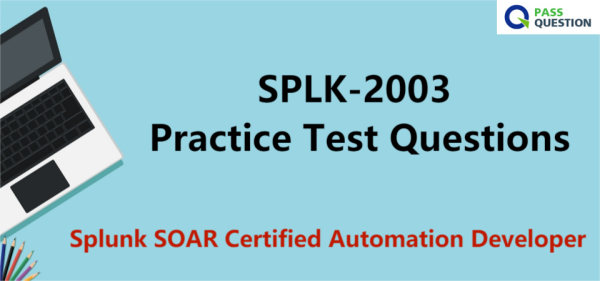SPLK-2003 Practice Test Questions - Splunk SOAR Certified Automation Developer
If you want to become a Splunk SOAR Certified Automation Developer, then you should consider using PassQuestion SPLK-2003 Practice Test Questions so you can pass Splunk SPLK-2003 exam on the first attempt. You will have to use our SPLK-2003 Practice Test Questions multiple times so you can ensure your success in the real exam. It will provide you a real exam scenario so you can get a better idea of how you can prepare for the Splunk SOAR Certified Automation Developer exam. Make sure that you are using SPLK-2003 Practice Test Questions that are created by the experts and will help you clear your exam on the first attempt.

Splunk SOAR Certified Automation Developer SPLK-2003 Exam Overview
The Splunk SOAR Certified Automation Developer exam is the final step towards completion of the Splunk SOAR Certified Automation Developer certification track—formerly referred to as Splunk Phantom Certified Admin. This highly technical certification exam is a 57-minute, 58-question assessment which evaluates a candidate's knowledge and skills in installing and configuring a SOAR (Phantom) server and integrating it with Splunk, as well as planning, designing, creating, and debugging playbooks. Candidates can expect an additional 3 minutes to review the exam agreement, for a total seat time of 60 minutes.
Exam Content
The following content areas are general guidelines for the content to be included on the exam.
Installation/Initial configuration
Apps and assets
User management
Ingesting data
Events and containers
Mission control
Running actions and playbooks
Case management/workflows
Multi-tenacity
Clustering
Automation best practices
The visual playbook editor
Using actions and decisions
Using action results
Testing and debugging playbooks
Using interaction
Output formatting
Complex logic
Interacting with artifacts
Using the vault in a playbook
Custom lists
Integrating Splunk with SOAR
Exam Objectives
1.0 Deployment, Installation, and Initial Configuration 5%
2.0 User Management and Multi-tenancy 5%
3.0 Apps, Assets, and Playbooks 5%
4.0 Analyst Queue 5%
5.0 The Investigation Page 10%
6.0 Case Management and Workbooks 5%
7.0 Customizations 5%
8.0 System Maintenance 5%
9.0 Introduction to Playbooks 5%
10.0 Visual Playbook Editor 5%
11.0 Logic, Filters, and User Interaction 5%
12.0 Formatted Output and Data Access 5%
13.0 Modular Playbook Development 5%
14.0 Custom Lists and Data Routing 5%
15.0 Configuring External Splunk Search 5%
16.0 Integrating SOAR into Splunk 10%
17.0 Custom Coding 5%
18.0 Using REST 5%
View Online Splunk SOAR Certified Automation Developer SPLK-2003 Free Questions
How is it possible to evaluate user prompt results?
A.Set action_result.summary. status to required.
B.Set the user prompt to reinvoke if it times out.
C.Set action_result. summary. response to required.
D.Add a decision Mode
Answer : B
Which Phantom VPE Nock S used to add information to custom lists?
A.Action blocks
B.Filter blocks
C.API blocks
D.Decision blocks
Answer : C
Which app allows a user to run Splunk queries from within Phantom?
A.Splunk App for Phantom?
B.The Integrated Splunk/Phantom app.
C.Phantom App for Splunk.
D.Splunk App for Phantom Reporting.
Answer : A
Which Phantom API command is used to create a custom list?
A.phantom.add_list()
B.phantom.create_list()
C.phantom.include_list()
D.phantom.new_list()
Answer : A
Which of the following accurately describes the Files tab on the Investigate page?
A.A user can upload the output from a detonate action to the the files tab for further investigation.
B.Files tab items and artifacts are the only data sources that can populate active cases.
C.Files tab items cannot be added to investigations. Instead, add them to action blocks.
D.Phantom memory requirements remain static, regardless of Files tab usage.
Answer : D
When is using decision blocks most useful?
A.When selecting one (or zero) possible paths in the playbook.
B.When processing different data in parallel.
C.When evaluating complex, multi-value results or artifacts.
D.When modifying downstream data hi one or more paths in the playbook.
Answer : A
- TOP 50 Exam Questions
-
Exam
All copyrights reserved 2025 PassQuestion NETWORK CO.,LIMITED. All Rights Reserved.

